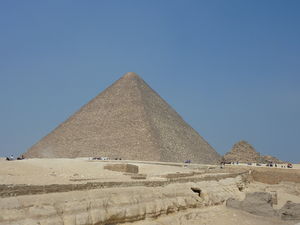CZ:Featured article/Current: Difference between revisions
Jump to navigation
Jump to search
imported>Chunbum Park (→Silent letters in English: Wonders of the world) |
imported>Chunbum Park |
||
| Line 3: | Line 3: | ||
Various lists of the '''Wonders of the World''' have been compiled throughout history. The most well known are the [[Seven Wonders of the Ancient World]]. These lists have been compiled over the ages to catalogue and to categorize the most spectacular man-made constructions and natural phenomena in the world. The number seven was chosen because the Greeks believed it to be the representation of perfection and plenty, and later was usually retained in analogy to conform with this ancient practice. | Various lists of the '''Wonders of the World''' have been compiled throughout history. The most well known are the [[Seven Wonders of the Ancient World]]. These lists have been compiled over the ages to catalogue and to categorize the most spectacular man-made constructions and natural phenomena in the world. The number seven was chosen because the Greeks believed it to be the representation of perfection and plenty, and later was usually retained in analogy to conform with this ancient practice. | ||
==Seven Wonders of the Ancient World== | ===Seven Wonders of the Ancient World=== | ||
{{Image|Great Pyramid of Giza, 2011.jpg|right|300px|The [[Great Pyramid of Giza]]}} | {{Image|Great Pyramid of Giza, 2011.jpg|right|300px|The [[Great Pyramid of Giza]]}} | ||
:''Main Article:[[Seven Wonders of the Ancient World]]'' | :''Main Article:[[Seven Wonders of the Ancient World]]'' | ||
Revision as of 08:52, 8 December 2012
Wonders of the world
Various lists of the Wonders of the World have been compiled throughout history. The most well known are the Seven Wonders of the Ancient World. These lists have been compiled over the ages to catalogue and to categorize the most spectacular man-made constructions and natural phenomena in the world. The number seven was chosen because the Greeks believed it to be the representation of perfection and plenty, and later was usually retained in analogy to conform with this ancient practice.
Seven Wonders of the Ancient World
- Main Article:Seven Wonders of the Ancient World
The historian Herodotus (484 BC–ca. 425 BC), and the scholar Callimachus of Cyrene (ca 305–240 BC) at the Museum of Alexandria, made early lists of Seven wonders but their writings have not survived, except as references. The seven wonders included:
- Great Pyramid of Giza
- Hanging Gardens of Babylon
- Statue of Zeus at Olympia
- Temple of Artemis at Ephesus
- Mausoleum of Maussollos at Halicarnassus
- Colossus of Rhodes
- Lighthouse of Alexandria
| notes |
|---|
